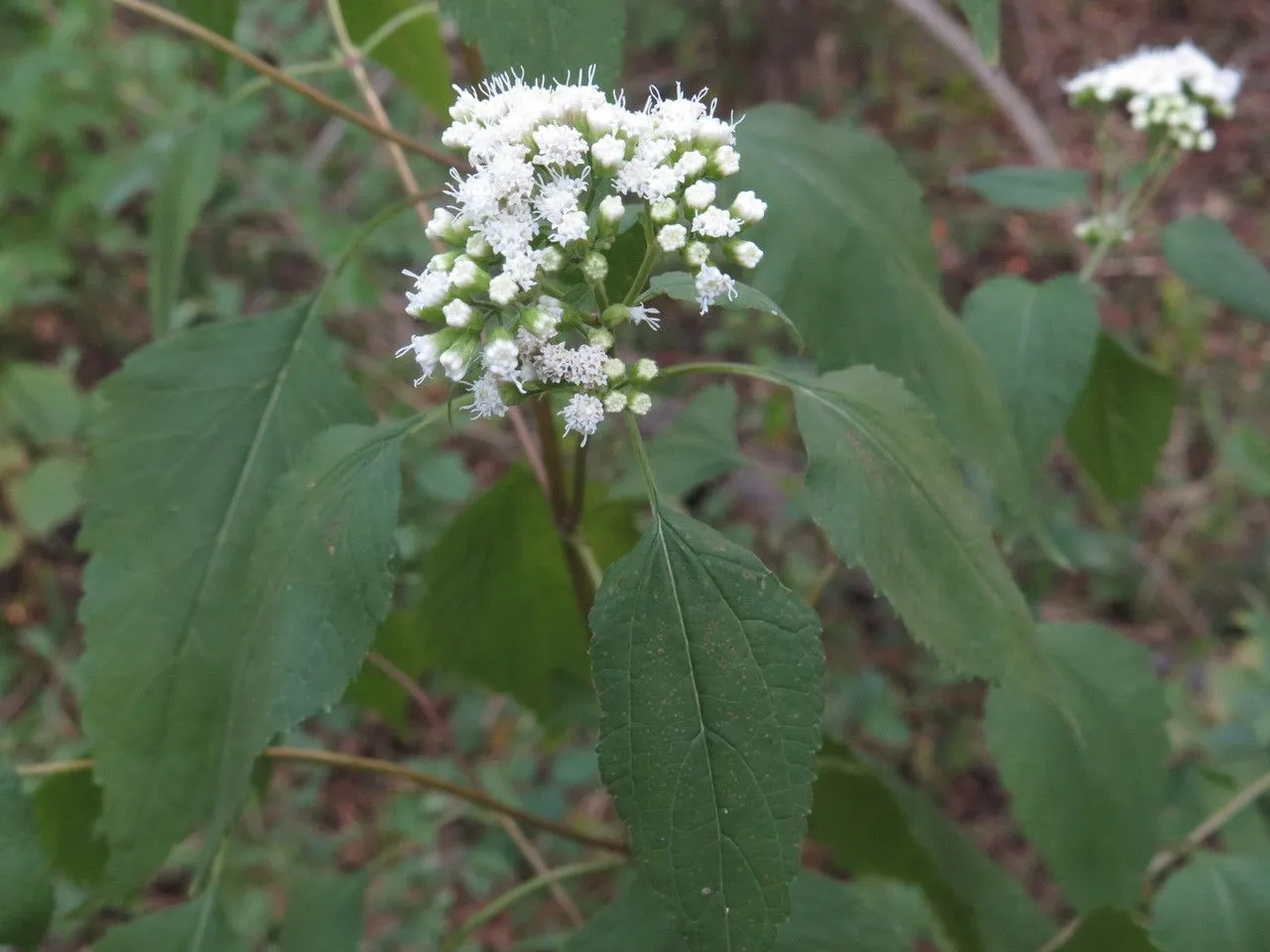
Author: (L.) Spach
Bibliography: Hist. Nat. Vég. (Spach) 10: 286 (1841)
Year: 1841
Status: accepted
Rank: species
Genus: Ageratina
Vegetable: Unknown
Observations: E. U.S.A.
Lesser snakeroot, scientifically known as Ageratina aromatica, is a notable member of the Asteraceae family. The plant was first described in 1841 by the botanist Édouard Spach in his comprehensive work “Hist. Nat. Vég.”. It is predominantly found in the eastern regions of the United States, where it thrives in a variety of habitats.
Ageratina aromatica is recognized for its aromatic properties and its striking seasonal blooms. The plant typically grows in woodlands and along forest edges, showcasing its adaptability to different environmental conditions. Lesser snakeroot features clusters of small, white to lavender flowers that attract a variety of pollinators, making it a beneficial addition to natural gardens aimed at supporting local wildlife.
The foliage of Ageratina aromatica is equally noteworthy; its leaves are finely serrated and emit a subtle but pleasant fragrance when crushed. This aromatic quality not only gives the plant its specific name but also makes it a charming plant for human gardeners who enjoy sensory experiences in their landscapes.
Historically, lesser snakeroot has been used for various medicinal purposes by indigenous and early settler communities in the United States. Its purported ability to treat snake bites and other ailments has made it a plant of interest both culturally and pharmaceutically.
Despite its common name and medicinal applications, caution is advised when using any part of the plant for therapeutic purposes without proper guidance and knowledge, as the biochemical properties of plants can have potent effects.
In garden settings, lesser snakeroot is appreciated not just for its aesthetic appeal but also for its role in maintaining ecological balance. It pairs well with other native plants, contributing to a resilient and sustainable garden ecosystem. Gardeners should consider its moderate to high moisture requirements and its preference for well-drained soils, ensuring it receives adequate sunlight, though it can also tolerate partial shade.
In sum, Ageratina aromatica, or lesser snakeroot, is a valuable plant species in both natural and cultivated landscapes of the eastern United States. Its historical significance, aromatic features, and ecological benefits make it a noteworthy plant within the rich tapestry of North American flora.
Eng: lesser snakeroot
En: Lesser snakeroot
Taken Oct 3, 2022 by Justin S (cc-by-sa)
Taken Oct 20, 2022 by Irene White (cc-by-sa)
Taken Oct 3, 2020 by S P (cc-by-sa)
Taken Sep 21, 2019 by karma Karma (cc-by-sa)
Taken Sep 27, 2021 by lori law (cc-by-sa)
Taken Sep 22, 2022 by Loki Loki kenata (cc-by-sa)
Taken Aug 27, 2022 by Eileen Rap (cc-by-sa)
Taken Aug 12, 2020 by Bucky Carrington (cc-by-sa)
Taken Oct 10, 2015 by EOL − yaoshawn (cc-by-nc)
Taken Aug 6, 2021 by Charles Sensenbrenner (cc-by-sa)
Taken Sep 27, 2020 by Dylan Lipuma-Vaughn (cc-by-sa)
Taken Oct 10, 2015 by EOL − yaoshawn (cc-by-nc)
Taken Oct 29, 2015 by EOL − wanchen (cc-by-nc)
Taken Oct 29, 2015 by EOL − wanchen (cc-by-nc)
Taken Oct 10, 2015 by EOL − yaoshawn (cc-by-nc)
Taken Sep 27, 2020 by Lisa Johnson (cc-by-sa)
Taken Aug 24, 2021 by Matthew Campbell (cc-by-sa)
Taken Sep 8, 2021 by Mark Caruso (cc-by-sa)
Taken Oct 8, 2022 by Sebra Debrecht (cc-by-sa)
Taken Sep 18, 2020 by Blaize (cc-by-sa)
Family: Myrtaceae Author: (F.Muell.) K.D.Hill & L.A.S.Johnson Bibliography: Telopea 6: 402 (1995) Year: 1995 Status:…
Family: Rubiaceae Author: Pierre ex A.Froehner Bibliography: Notizbl. Bot. Gart. Berlin-Dahlem 1: 237 (1897) Year:…
Family: Sapindaceae Author: Koidz. Bibliography: J. Coll. Sci. Imp. Univ. Tokyo 32(1): 38 (1911) Year:…
Family: Asteraceae Author: A.Gray Bibliography: Pacif. Railr. Rep.: 107 (1857) Year: 1857 Status: accepted Rank:…
Family: Fabaceae Author: Medik. Bibliography: Vorles. Churpfälz. Phys.-Ökon. Ges. 2: 398 (1787) Year: 1787 Status:…
Family: Aspleniaceae Author: (Cav.) Alston Bibliography: Bull. Misc. Inform. Kew 1932: 309 (1932) Year: 1932…